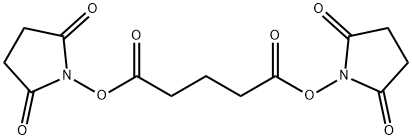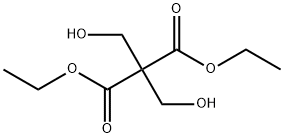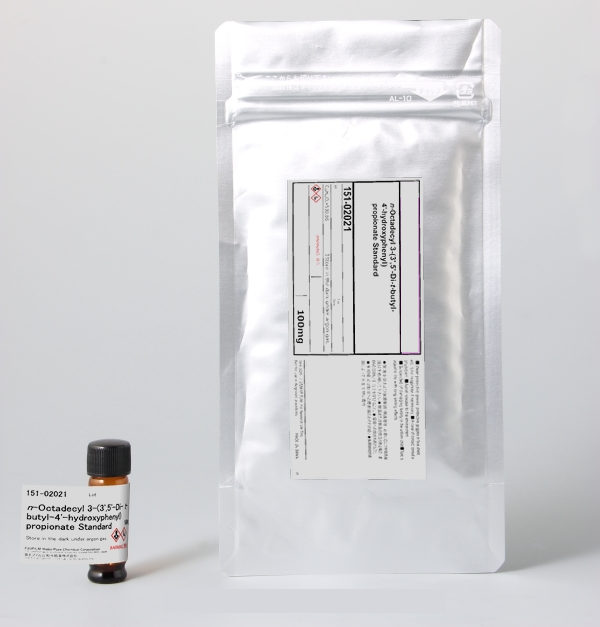Disuccinimidyl glutarate
Synonym(s):CDHF4;desmoglein 1;DG1;DSG
- CAS NO.:79642-50-5
- Empirical Formula: C13H14N2O8
- Molecular Weight: 326.26
- MDL number: MFCD00153597
- SAFETY DATA SHEET (SDS)
- Update Date: 2025-12-22 18:23:36

What is Disuccinimidyl glutarate?
Description
Disuccinimidyl glutarate (DSG) is a homobifunctional crosslinking agent that contains amine-reactive N-hydroxysuccinimide (NHS) ester groups at each end. DSG is membrane-permeable and non-cleavable. DSG can be combined with formaldehyde fixation to improve the detection of specific protein-DNA complexes.
Chemical properties
DSG crosslinker (Disuccinimidyl glutarate; Di(N-succinimidyl) glutarate) is a homobifunctional crosslinking reagent that is membrane permeable. DSG protein crosslinker is often used in ChIP assays to determine DNA-protein binding interactions; using DSG and formaldehyde in a two-step crosslinking strategy greatly improves the ChIP assay. Disuccinimidyl crosslinkers include disuccinimidyl glutarate (DSG), disuccinimidyl suberate (DSS), and bis-N-succinimidyl-(pentaethylene glycol) ester (BS(PEG)5)[1]. DSG crosslinking takes place through amine-reactive NHS esters at both ends of a 5-atom (7.7 angstrom) spacer arm. DSS (crosslinker arm length = 11.4Å), DSG (crosslinker arm length = 7.5Å), and disuccinimidyl tartrate (DST, crosslinker arm length = 5.8Å) are homobifunctional crosslinking reagents that react specifically with primary amines[2]. DSG crosslinker must be dissolved in an organic solvent, such as DMSO or DMF, and then added to an aqueous crosslinking reaction. The directly water-soluble version of Di(N-succinimidyl) glutarate (DSG) is BS2G.
Characteristics
Features of disuccinimidyl glutarate:
Reactive groups: NHS ester (both ends)
Reactive towards: amino groups (primary amines)
Non-cleavable
Water-insoluble (dissolve first in DMF or DMSO)
Membrane-permeable, allowing for intracellular crosslinking
Can increase crosslinking efficiency compared to DSS in some applications
The Uses of Disuccinimidyl glutarate
Disuccinimidyl glutarate is used as a membrane-soluble, amine-reactive N-hydroxysuccinamide ester-based homobifunctional crosslinking reagent. It is a homobifunctionla cross-linking reagent, for ex. isolation of the insulin receptor.
What are the applications of Application
Disuccinimidyl glutarate is an amine-reactive, NHS ester-based crosslinker useful in isolation of the insulin receptor.
General Description
DSG crosslinker (Disuccinimidyl glutarate; Di(N-succinimidyl) glutarate) is a homobifunctional crosslinking reagent that is membrane permeable. DSG protein crosslinker is often used in ChIP assays to determine DNA-protein binding interactions; using DSG and formaldehyde in a two-step cross-linking strategy greatly improves the ChIP assay.
DSG crosslinking takes place through amine-reactive NHS esters at both ends of a 5-atom (7.7 angstrom) spacer arm. DSG crosslinker must be dissolved in an organic solvent, such as DMSO or DMF, then added to an aqueous crosslinking reaction. The directly water soluble version of Di(N-succinimidyl) glutarate (DSG) is BS2G.
References
[1] JeeYoung Kim, Min Park, Gun Yong Sung. “Efficient Portable Urea Biosensor Based on Urease Immobilized Membrane for Monitoring of Physiological Fluids.” Biomedicines (2020).
[2] Petr Novak. “A top-down approach to protein structure studies using chemical cross-linking and Fourier transform mass spectrometry.” European Journal of Mass Spectrometry 9 6 (2003): 623–31.
Properties of Disuccinimidyl glutarate
| Melting point: | 168-172 °C |
| Boiling point: | 485.1±55.0 °C(Predicted) |
| Density | 1.53±0.1 g/cm3(Predicted) |
| storage temp. | -20°C |
| solubility | DMSO (Sparingly, Sonicated), Methanol (Slightly, Sonicated) |
| form | Solid |
| color | White to Off-White |
| Water Solubility | Soluble in dimethylsulfoxide and dimethylformamide. Partially soluble in water. |
| Sensitive | Moisture Sensitive |
| BRN | 8575145 |
| Stability: | Hygroscopic, Moisture Sensitive, Unstable in Aqueous Solution |
| InChI | InChI=1S/C13H14N2O8/c16-8-4-5-9(17)14(8)22-12(20)2-1-3-13(21)23-15-10(18)6-7-11(15)19/h1-7H2 |
| CAS DataBase Reference | 79642-50-5 |
Safety information for Disuccinimidyl glutarate
| Signal word | Warning |
| Pictogram(s) |
 Exclamation Mark Irritant GHS07 |
| GHS Hazard Statements |
H315:Skin corrosion/irritation H319:Serious eye damage/eye irritation H335:Specific target organ toxicity, single exposure;Respiratory tract irritation |
| Precautionary Statement Codes |
P261:Avoid breathing dust/fume/gas/mist/vapours/spray. P264:Wash hands thoroughly after handling. P264:Wash skin thouroughly after handling. P271:Use only outdoors or in a well-ventilated area. P280:Wear protective gloves/protective clothing/eye protection/face protection. P302+P352:IF ON SKIN: wash with plenty of soap and water. P305+P351+P338:IF IN EYES: Rinse cautiously with water for several minutes. Remove contact lenses, if present and easy to do. Continuerinsing. |
Computed Descriptors for Disuccinimidyl glutarate
| InChIKey | LNQHREYHFRFJAU-UHFFFAOYSA-N |
| SMILES | C(ON1C(=O)CCC1=O)(=O)CCCC(ON1C(=O)CCC1=O)=O |
New Products
Indole Methyl Resin tert-butyl 9-methoxy-3-azaspiro[5.5]undecane-3-carboxylate Boc-His(Boc)-OH 2-CTC Resin 4-Chloro-7-tosy1-7Hpyrrolo[2,3-d]pyrimidine 5,7-Dibromo-1H-indole 2,5-dichloro-N-hydroxy-4,6-dimethylpyridine-3-carboximidamide 2,2-Dimethoxy-7-azaspiro[3.5]nonane hydrochloride 4-chloromethyl-5-methyl-1,3-dioxol-2-one (DMDO-Cl) R-2-BENZYLOXY PROPIONIC ACID 1,1’-CARBONYLDIIMIDAZOLE 1,1’-CARBONYLDI (1,2-4 TRIAZOLE) N-METHYL INDAZOLE-3-CARBOXYLIC ACID 4-((2-hydroxyethyl)thio)benzoic acid 1-(TERT-BUTOXYCARBONYL)-2-PYRROLIDINONE Methyl 6-methylnicotinate 3-Pyridineacrylic acid tert-Butyl carbazate TETRAHYDRO-2H-PYRAN-3-OL 2-((4-morpholinophenylamino) (methylthio) methylene) malononitrile 3-(4-morpholinophenylamino)-5-amino-1H-pyrazole-4-carbonitrile 2,4-dihydroxybenzaldehyde 1,3-Diethyl-1,3-Diphenylurea Methyl 2-methylquinoline-6-carboxylateRelated products of tetrahydrofuran





![Bicyclo[1.1.1]pentane-1,3-dicarboxylic acid, MonoMethyl ester](https://img.chemicalbook.in/CAS/GIF/83249-10-9.gif)
![bicyclo[2.2.2]oct-5-ene-2,3-dicarboxylic anhydride](https://img.chemicalbook.in/CAS/GIF/6708-37-8.gif)
![Bicyclo[1.1.1]pentane-1,3-dicarboxylic acid](https://img.chemicalbook.in/CAS/GIF/56842-95-6.gif)
You may like
-
 Disuccinimidyl glutarate 96% CAS 79642-50-5View Details
Disuccinimidyl glutarate 96% CAS 79642-50-5View Details
79642-50-5 -
 Di(N-succinimidyl) glutarate CAS 79642-50-5View Details
Di(N-succinimidyl) glutarate CAS 79642-50-5View Details
79642-50-5 -
 Pyridine 99.5% HPLC /UV SpectroscopyView Details
Pyridine 99.5% HPLC /UV SpectroscopyView Details
110-86-1 -
 Piperazine Spot supply, best priceView Details
Piperazine Spot supply, best priceView Details
110-85-0 -
 Dibutyl PhthalateView Details
Dibutyl PhthalateView Details
84-74-2 -
 Imidazole Spot supply, competitive priceView Details
Imidazole Spot supply, competitive priceView Details
288-32-4 -
 Octadecyl 3-(3,5-di-tert-butyl-4-hydroxyphenyl)propionate 98% (GC)View Details
Octadecyl 3-(3,5-di-tert-butyl-4-hydroxyphenyl)propionate 98% (GC)View Details
2082-79-3 -
 Thiourea 99% ARView Details
Thiourea 99% ARView Details
62-56-6
